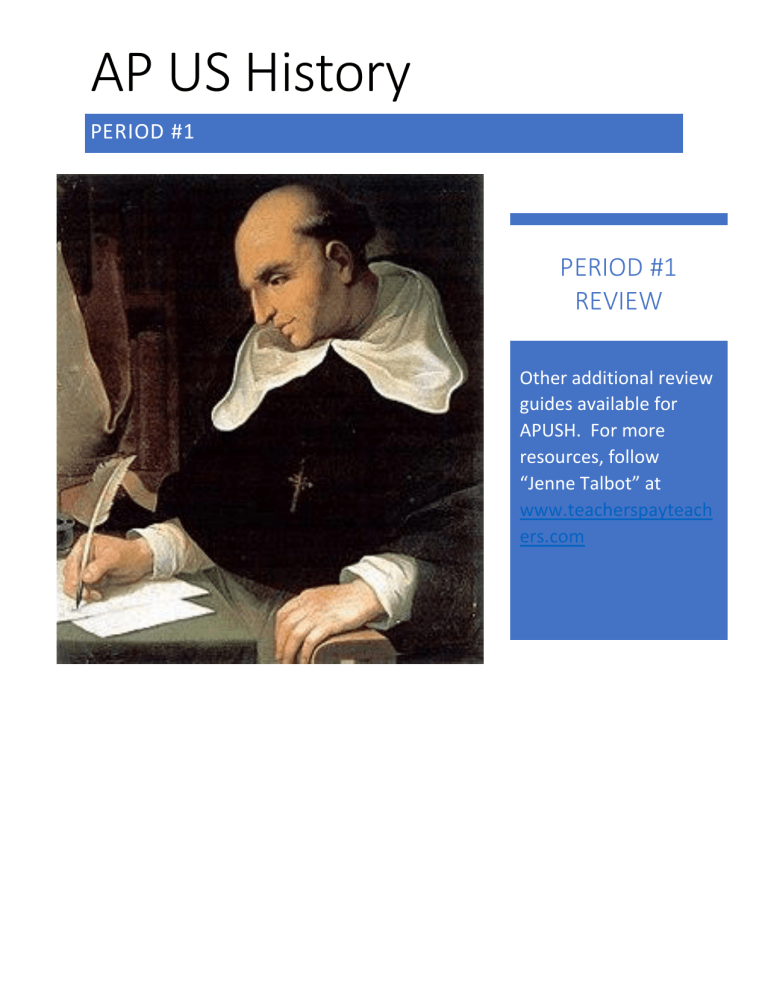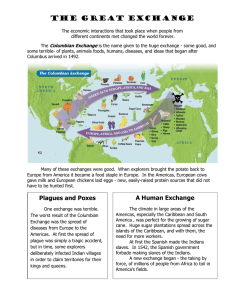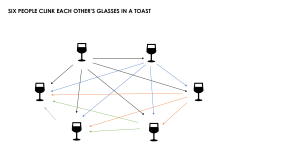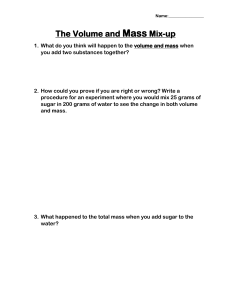
AP US History PERIOD #1 PERIOD #1 REVIEW Other additional review guides available for APUSH. For more resources, follow “Jenne Talbot” at www.teacherspayteach ers.com Reading Guide Use the following as a starting point for reviewing the periods. • What are connections between items (look for arrows) • Why is the item significant (important)? (look for this symbol) • What are the significant events from this time period? Who is significant from this time period? What is the overarching theme of this unit? • • • What are connections to previous time period/events? What are connections to future time periods/events? • What items are unclear or unfamiliar to you? • Big Idea #1: As Native American populations moved and settled across North America, they developed unique and complex societies by adapting to and transforming their environments. Influence of Physical Geography • • • • Most Western native people fished, hunted and gathered in the bountiful land. Along the Colorado River, Native Americans gathered a variety of wild food and planted some tobacco. Acorns were a pivotal part of the Californian diet. Women would gather and process the acorns. In the Pacific Northwest, people foraged for pine nuts, wild plants, and more. Salmon was plentiful along the Columbia and Colorado rivers. Native fishermen would use large harpoons to stab the fish swimming through the rushing water, along with complex trapping systems. • • • • • In the dry climate of the Southwest, the Ancestral Pueblos developed complex irrigation systems which maintained crops even in the hot sun. This new irrigation system allowed the Pueblos to begin planting beans and squash, in addition to corn. With surplus food and stability, they became more sedentary, living in stone and adobe houses. Lived in larger towns with thousands of people and intricate dwellings. The extended family lived and worked together, both male and female participating in the traditionally-women dominated agricultural process. • • As the Plains Indians became more focused on hunting, they became more nomadic their societies were well organized and missionaligned, just mobile. The teepee—a conical tent made out of a buffalo skin and wood—was easy to put up and take down if a band was following a buffalo herd for hunting. Sometimes, Plains Indians lived in a combination of nomadic and sedentary settings: they would plant crops and establish villages in the spring, hunt in the summer, harvest their crops in the fall, and hunt in the winter. Geography created DIFFERENT and COMPLEX societies • • • • As the Northeast became more agricultural, the region became more urbanized. The farming industry required people to begin to live together and create more fortified villages to protect their harvests. They lived in longhouses that would extend up to one hundred feet. Since Algonquians farmed while also maintaining hunting and fishing, they “commuted” from less permanent villages of wigwams. As certain tribes, like the Iroquois, began having immense farming and thereby trading success, intertribal violence intensified - They devised a system by which each tribe could maintain a level of autonomy over local affairs, but the League would unite over trade policies and diplomacy issues. The Iroquois Confederacy put forth republican principles, and a dual system of federalism, or balancing local and national powers, for the first time on American land. Therefore, many historians argue, the League, which would later become known as the Iroquois Confederacy, was the first American democracy, established at minimum four hundred years before the US Constitution of 1787. Big Idea #2: Contact between Europeans, Native Americans, and Africans resulted in changes in both Europe and the Americans Why did Europe explore the Americas? - “God, Gold, and Glory” GOD Religious Passion The Crusades and the Reconquista cemented religious intolerance, and the Christians looked to colonization partly as a means of continuing religious conquests. Particularly in the strongly Catholic nations of Spain and Portugal, religious zeal motivated the rulers to convert Native Americans and sanctify Christian global dominance GOLD Expanded Trade (Silk Road), Desire for a Water route GLORY Adventure, Power, National Pride Example: Competition between Portugal and Spain Portuguese Spanish Prince Henry the Navigator • • • • • • New Ship Designs: Caravel (Ability to sail into the wind) New Navigation Technology: o Astrolabe – ability to develop latitude o Magnetic Compass – locate direction Columbia Exchange Exchange of plants, animals, and diseases that changed lives and landscapes on both sides of the ocean. Ferdinand and Isabelle • Exploration of Africa in 1400s Open slave trade with Africa • Sugar plantations Felt threatened by Portuguese monopoly on slave trade and expansion Worked with Christopher Columbus Changes in Americas Widespread, Deadly Epidemics from European Disease • • Microbes to which native inhabitants had no immunity caused sickness and death everywhere Europeans settled. Examples: Along the New England coast between 1616 and 1618, epidemics claimed the lives of 75 percent of the native people. In the 1630s, half of the Huron and Iroquois people living near the Great Lakes died of smallpox. The very young and the very old were the most vulnerable and had the highest mortality rates. The loss of the older generation meant the loss of knowledge and tradition, while the death of children only compounded the trauma. Example: Sugar Of all the commodities in the Atlantic World, sugar proved to be the most important. Indeed, in the colonial era, sugar carried the same economic importance as oil does today. European rivals raced to create sugar plantations in the Americas and fought wars for control of production. Although refined sugar was available in the Old World, Europe’s harsher climate made sugarcane difficult to grow. Columbus brought sugar to Hispaniola in 1493, and the new crop thrived. Over the next century of colonization, Caribbean islands and most other tropical areas became centers of sugar production, which in turn fueled the demand to enslave Africans for labor. Need for Labor -Spanish Encomienda System • • • Importing of African Slaves Spain’s experiments in enslaving Indians were failing - the Spanish began to exploit a new labor force: slaves from western Africa. The first African slaves were brought to the New World as early as 1502, where they would mine precious metals and raise sugar, coffee, and tobacco--the first goods sold to a mass consumer market. By the mid-eighteenth century, slaves could be found everywhere in the Americas from French Canada to Chile. o Between 1492 and 1820, approximately ten to fifteen million Africans were forcibly brought to the New World, while only about two million Europeans had migrated. Changes in Europe The joint-stock company was the forerunner of the modern corporation. In a JOINT-STOCK VENTURE, stock was sold to high net-worth investors who provided CAPITAL and had limited RISK. These companies had proven profitable in the past with trading ventures. The risk was small, and the returns were fairly quick Interaction between Native Americans and Europeans Cultural Differences Overtime, adopting of useful aspects of each other’s culture Effect of Horse on Plains Indians • • • Tribes became less settled and sedentary: allowed them to hunt the buffalo Ability to roam led to increased conflict between tribes as it increased contact and conflict Allowed them to have a greater ability to trade and got access to new items (Such as blankets, larger teepees, and firearms) Native peoples sought to defend and maintain their political sovereignty, economic prosperity, religious beliefs, and concepts of gender relations through diplomatic negotiations and military resistance. Example: Pueblo Revolt • Spanish establish political base 1610 in Santa Fe o Missionaries built churches forced conversion to Christianity o Demanded corn and labor from the Pueblos • Long period of drought - “When Jesus came, the Corn Mothers went away” • 1680 Pueblos attacked Spanish o Killed 400 Spaniards and drove 2,000 South towards Mexico ▪ Destroyed Mission churches • 12 Years of Independence o Reestablish their own religion and government • Droughts and Attacks by Rival Indians continued • Spanish take control in 1692 • Many Pueblo quietly resist Christianity Debate in Europe: How to interact with Native Americans (and Africans)? • Conversion to Christianity o Priests ordered to convert the local people to Christianity o Enslavement Dissent • Priest Bartolome de Las Casas • Convert using love, gentleness, and kindness o “When they (Spaniards) have slain all those who fought for their lives or to escape the tortures the would have to endure, that is to say, when they have slain all the native rulers and young men (since the Spaniards usually pare only the women and children, who are subjected to the hardest and bitterest servitude ever suffered by man or beast, they enslave any survivors. With these infernal methods of tyranny they debase and weaken countless numbers of those pitiful Indian nations.” • After Pueblo Revolt: Adoption of “New Laws” – attempted to grant more rights/protection to native population o Not always followed





